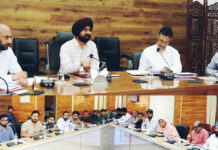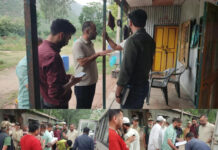JAMMU: Expecting a footfall of nearly six lakhs during the annual Amarnath Yatra, the Jammu and Kashmir administration on Sunday issued directions to widen walking tracks and build retaining walls with special focus on laying down prefabricated cement tiles on tracks from Baltal.
The directions were passed by Chief Secretary B V R Subrahmanyam, who chaired the 10th meeting of the High-Level Committee of Shri Amarnathji Shrine Board (SASB) here, an official spokesperson said. The annual pilgrimage usually starts in June-July on the traditional 36-km-long Pahalgam route in Anantnag district and the shorter 14-km-long Baltal route in Ganderbal district. It concludes in August, coinciding with Raksha Bandhan. The chief secretary reviewed in detail the facilities for safe, smooth, and secure movement of pilgrims, particularly along the Jammu-Srinagar national highway and the Baltal and the Chandanwari tracks up to the cave shrine located at an altitude of 3,880 metres in the South Kashmir Himalayas, the official said.
He said Subrahmanyam also reviewed the status of track upgradation work on both the routes, improvements at the access control gates, establishment of temporary camps, shelter sheds, health and medical camps and emergency operation centres at various locations, provisions of drinking water, lighting, LPG, rations, medicine and mobile connectivity besides the establishment of Joint Control Rooms as per NDMA suggestion. The chief secretary enjoined upon the administration to undertake preparations for an expected footfall of six lakh ”yatris” this year. “To further ensure secure passage of pilgrims, directions were issued to appropriately widen walking tracks, install railings, and construct retaining walls with special focus on laying down prefabricated cement tiles on tracks from Baltal,” the spokesperson said. He also directed the divisional commissioners of Jammu and Kashmir to closely monitor the arrangements being put in place in transit camps along the Yatra route, particularly at Kathua, Samba, Jammu, Udhampur, Ramban, Baltal, and Chandanwari.
The official also asked them to work out a plan for regulating passage of ”yatris” throughout the route from Lakhanpur to the cave shrine and back, giving due consideration to local traffic and movement of Kashmir-bound load carriers and trucks especially in the event of weather-induced blockade of the highway, the spokesperson said. He said arrangements related to scientific disposal of solid and liquid waste by the Sonmarg and the Pahalgam development authorities and the SASB were discussed. The agencies were asked to install bio-toilets, waste-specific garbage bins, mechanical segregator, auto-composter, and electromagnetic disintegrator at suitable locations on both Yatra routes. Arrangements with regard to registration and medical screening of ponies against Glander”s disease, establishment of pony sheds and veterinary camps, and roll-out of a pre-paid system for hiring of pony services were also reviewed, the spokesperson said.
To ensure timely completion of various projects and arrangements to be put in place, he said, it was impressed upon the departments concerned to initiate financial and administrative processes well in advance.



























